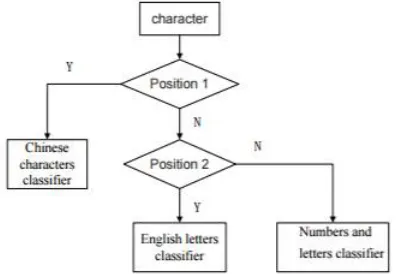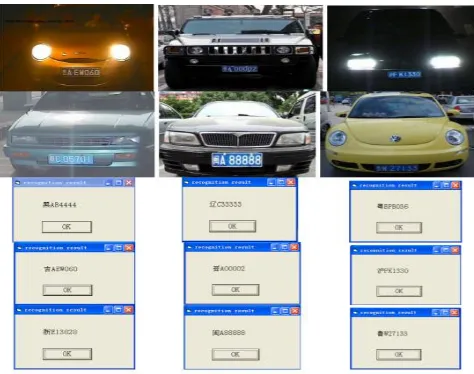Review Paper on License Plate Automatic
Recognition System using Different Technique
Etishri Chaturvedi1, Prof. Rajdeep Shrivastava2
M. Tech. Scholar, Dept. of Electronics & Communication, Lakshmi Narain College of Technology Excellence, Bhopal, India1
Assistant Professor, Dept. of Electronics & Communication, Lakshmi Narain College of Technology Excellence, Bhopal, India2
ABSTRACT: License Plate Recognition plays an important role on the traffic monitoring and parking management. Administration and restriction of those transportation tools for their better service becomes very essential. In this paper, a fast and real time method has an appropriate application to find plates that the plat has tilt and the picture quality is poor. In the proposed method, at the beginning, the image is converted into binary mode with use of adaptive threshold. And with use of edge detection and morphology operation, plate number location has been specified and if the plat has tilt; its tilt is removed away. Then its characters are distinguished using image processing techniques.
KEYWORDS: License Plate Recognition, Edge Detection, Image Processing, De-noising, MATLAB
I.INTRODUCTION
plate in an image. Methods which are symmetry based are mentioned in. In, firstly, it takes the input image into a gray scale, then for analyzing the location of plate the operation of morphology such as erosion and dilation is applied, and the plate is extracted with use of vertical and horizontal projection among various candidates. In the plate is a location with the black background and white writings. In this way that, firstly, takes the image into the HSI and applies the capability of being black color of its background for this purpose, it uses a mask and segments the image according to HSI color intensity parameter and creates a binary image. For cancelling probable noises, it uses the operation of erosion and dilation, then labels the existing candidates and for cancelling the candidates which aren’t the location of plate, it applies the geometric capability of the plate and other characters, then for recognizing a primary candidate, it uses the color intensity histogram, and recognizes the location of plate. In this paper a new method based on mathematical morphology and KNN classifier is presented that in comparison with other methods has better operation on a condition that plate was tilt in the images or ambient light was low.
II.IMAGE PROCESSING
When the license plate recognition systems are applied in outdoor areas, they are affected by weather and lighting conditions, as well as the complex backgrounds. This may bring noise to the acquired images. Noise is inevitable, but most of the noise can be eliminated with a smoothing filter. Through the de-noising procedure, subtle fractures can be linked and tiny abrupt parts can be softened. The principles that appear to be the most relevant to the image de-noising are preventing the original image edge from being destroyed, retaining the image outline and lines as much as possible, keeping the continuity of the image and increasing the contrast between regions of interest and not of interest. In this study, the standard median filter which has important features such as time saving, high precision and good performance is used. The center pixel in the scan window is to be de-noised. The first step is to sort all the pixel values in the scan window and find the mid-value, then change the mid-value into the standard median of the sorted sequence. Figures 1 and 2 show the experimental results. Through this method, information of image edges is saved as much as possible and the contrasts between regions of interest and not of interest are increased.
Figure 1: Original images
Figure 2: Results of De-noising
A.EDGE DETECTION
number of strokes is more and texture change is comparatively obvious. From Figure 4, it is noticed that compared with other areas, the gray area of the license plate changes more frequently and the edge information is richer. So the edge detection can be used to extract license plate area, separate prominent targets and background. This paper adopts method of Sobel edge detection. In Figure 3, the detection effect is shown.
Figure 3: Edge detection.
B.LICENSE PLATE LOCALIZATION
The starting point of the license plate location is to judge the license plate through the features of the car license plate area. Available license plate features include five aspects: (1) that the geometrical features of the license plate, that is the height, width and their proportions, are within the confines; (2) the form feature is that the license plate is in a rectangular frame and characters are arranged according to certain rules in the rectangular frame with intervals; (3) the gray distribution of car license plate area feature is that the horizontal lines through the license plate have a gray distribution of continuous peaks and troughs; (4) the horizontal or vertical projection characteristics of car license plate area present a continuous peaks and troughs distribution and (5), the spectrum processes the image by row or column DTF transformation and its diagram contains the location information of the license plate. According to the rules set in 2007 by the People’s Republic norm GA36 2007 mobile license plate standard in China, the basic characters of a vehicle license plate are as follows:
Color features. China has the following color placements for the license plate background and characters: blue background with white letters, and yellow-black, black-white, white background with red or black letters, etc. The color of background and character form a sharp contrast, and the license plate color is not consistent with the body color. In the surroundings, there is a low chance of finding the same color schemes, so the color can be used as a feature for license plate location. (2) Outline Size characteristics. The license plate size of small cars in China meets the standard X3–X7, with each character being 5 mm-wide and 90 mm-high. The space is 10 mm between Chinese characters and letters, while it is 12 mm between characters. It can be obtained according to the prior knowledge that the license plate location in the original image changes within a certain scope. (3) Character features. In vehicle images, areas around the license plate are, compared to other areas, rich in edge points and texture, and rectangular with a fixed aspect ratio. These unique features are adopted to distinguish the license plate from its background. Accordingly a license plate recognition method is developed based on fusion of significant features. This method improves the accuracy and adaptability of license plate localization.
III.FLOW CHART OF PLATE RECOGNITION
The recognition result is the minimum of S[i]
(1) The specific procedure is as follows: Firstly, according to the position, each character is categorized by the different classifiers, shown in Figure 4. Secondly, the characters that are to be identified with template characters are compared and their matching degree. Common pattern matching technique is a simple technique for the recognition of single font and fixed size character, which is a suitable approach for ANPR systems. Incorrectly segmented characters from the character segmentation stage, where characters are not in the expected position or few of them are missed, may affect the OCR recognition. The neural networks and statistical classifiers, which give better outcome compare to common pattern matching technique, can overcome this problem because of their strong memory and self-adapting ability.
IV.LICENSE PLATE RECOGNITION EXPERIMENT
The license recognition algorithm has been programmed using the MATLAB platform. The interface is shown in Figure 5. The algorithm has been tested under natural scenes in Chang Chun (China). The test pictures are taken by a CCD camera. Each picture contains only one license plate and has a resolution of 640 × 480.
MATLAB has been used for the implementation of the algorithm on a PC equipped with a Dual Core 2.4GHz and 3G RAM. It has also been used to generate the weights of neural network. 6436 binary images with varying resolutions from the previous character segmentation stage were used. First of all, the binary images of the characters are resized to the same size. To choose the right size, several sizes of input images have been used for neural network training. High recognition rates can be achieved by using large character images but this will result in a more complex structure of the neural network as the number of weights will increase. The size corresponding to the best suitable result is used for the final neural network.
A total of 300 vehicles images obtained from community entrance gates have been tested. The recognition algorithm shows a high accuracy rate of 92%. We can conclude that the license plate recognition algorithm proposed here is capable of identifying passenger car license plates against complex backgrounds.
V.CONCLUSION
In this paper, application software is designed for the recognition of civil vehicle license plates. License plate images were pre-processed and the plate locations were extracted first. Then, we corrected the skew of license plates and separated the plate characters individually by segmentation. Finally, according to the features of Chinese letters, we applied template matching with the use of an algorithm for recognition of plate characters. This system is designed for the identification of Chinese license plates and was tested over a large number of images. Finally through license plate recognition experiments, it was proven that the system designed in this study for Chinese license plate reorganization performed with better than 92% recognition rates.
REFERENCES
[1] Lv, X.; Wang, M.; Wang, G.; Peng, G. Study on license plate Segmentation. Comput. Eng. Appl. 2003, 15, 226–229.
[2] Anagnostopoulos, C.N.; Anagnostopoulos, I.; Kayafas, E.; Loumos, V. A license plate recognition algorithm for intelligent transportation system applications. IEEE Intell. Transp. Syst. 2006, 17, 377–392.
[3] Hongliang, B.; Changping, L. A Hybrid License Plate Extraction Method Based on Edge Statistics and Morphology. In Proceedings of the 17th International Conference on Pattern Recognition, Cambridge, UK, 23–26 August 2004; pp. 831–834.
[4] C. Anantha Reddy, C. Shoba Bindu, “Multi-Level Genetic Algorithm for Recognizing Multiple License Plates in a Single Image”, Journal of Innovation in Computer Science and Engineering, 2015.
[5] Anand Sumatilal Jain, Jayshree M. Kundargi, “Automatic Number Plate Recognition Using Artificial Neural Network”, International Research Journal of Engineering and Technology (IRJET), 2015.
[6] Zheng, D.; Zhao, Y.; Wang, J. An efficient method of license plate location. Pattern Recognit. Lett. 2005, 26, 2431–2438.
[7] Kim, K.I.; Jung, K.; Kim, J.H. Color texture-based object detection: An application to license plate localization. Lect. Notes Comput. Sci. 2002, 2388/2002, 321–335.
[8] Draghici, S. A neural network based artificial vision system for license plate recognition. Int. J. Neural Syst. 1997, 8, 113–126.
[9] Franc, V.; Hlavac, V. License plate character segmentation using hidden markov chains. Lect. Notes Comput. Sci. 2005, 3663/2005, 385–392.
[10] Xiaojun Zhai, Faycal Bensaali, “Standard Definition ANPR System on FPGA and an Approach to Extend it to HD” in 2013 IEEE GCC Conference and exhibition, November 17-20, Doha, Qatar. pp.214
[11] H. Erdinc Kocer and K. Kursat Cevik, "Artificial neural networks based vehicle license plate recognition," Procedia Computer Science, vol. 3, pp. 1033-1037, 2011.
[12] A Roy and D.P Ghoshal, "Number Plate Recognition for use in different countries using an improved segmentation," in 2nd National Conference on Emerging Trends and Applications in Computer Science(NCETACS), 2011, pp. 1-5.
[13] Fikriye Öztürk and Figens Özen, "A New License Plate Recognition System Based on Probabilistic NeuralNetworks," Procedia Technology, vol. 1, pp. 124- 128,2012.
[14] Zhigang Zhang and Cong Wang, "The Research of Vehicle Plate Recognition Technical Based on BP Neural Network," AASRI Procedia, vol. 1, pp. 74-81, 2012.



